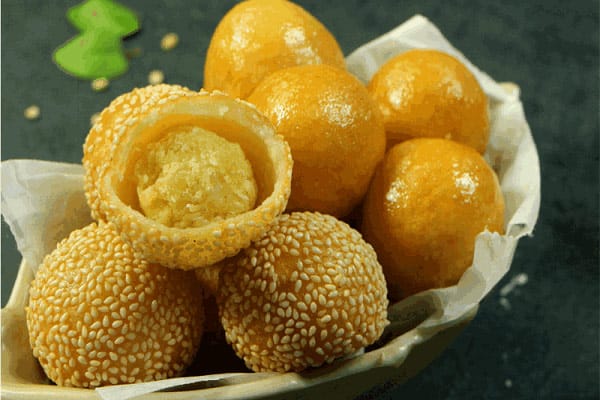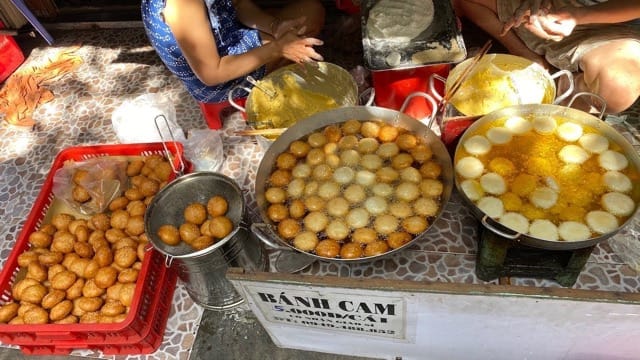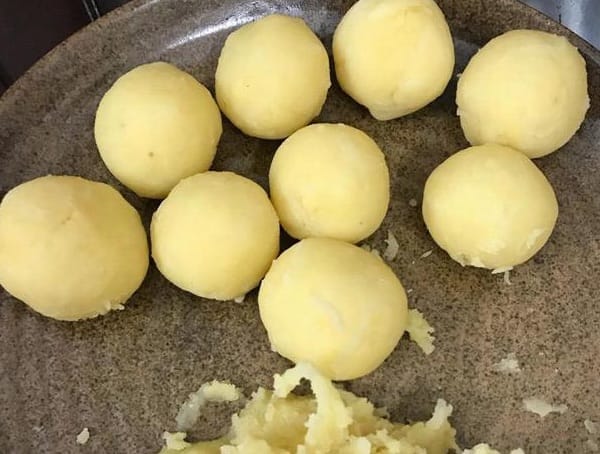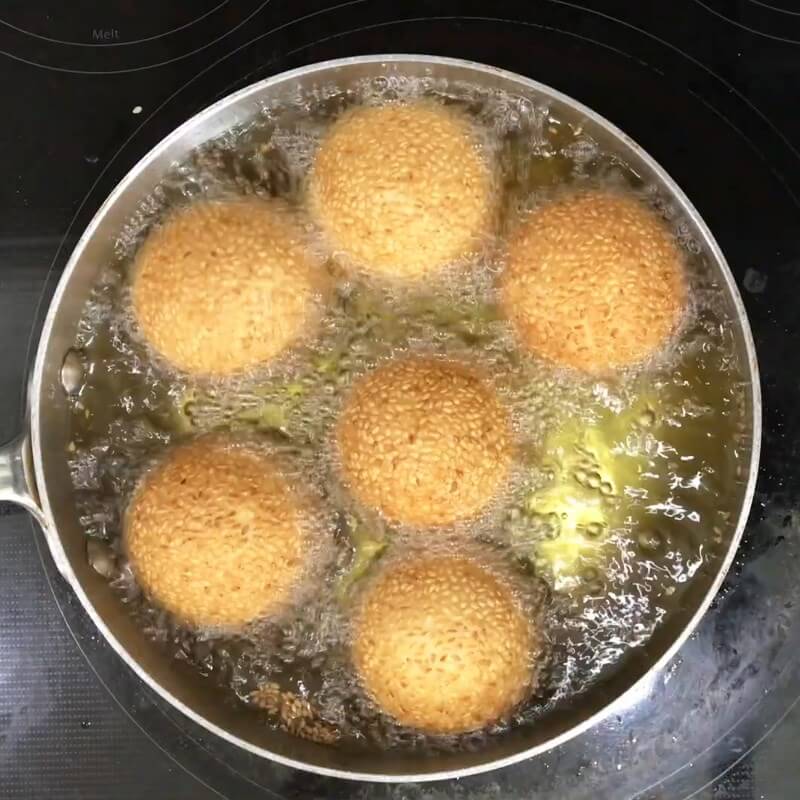Make sure to include Banh Cam in your must-try dishes when visiting Vietnam. This delectable Vietnamese delicacy combines a soft interior with a crispy outer layer, creating a delightful contrast.
Banh Cam, also referred to as Orange Cake, has gained worldwide acclaim as one of the top fried foods, as recognized by CNN Travel. Let’s delve into the cultural significance of Banh Cam and explore its role in Vietnamese cuisine.
Contents
What is Vietnamese sesame balls (Orange Cakes Or Vietnamese Sesame Balls)?
Understanding Banh Cam and Its Cultural Significance
Banh Cam, also known as “Orange Cake,” is a cherished Vietnamese dessert that has gained recognition both within and beyond Vietnam. This sweet delight derives its name from its round shape and golden-brown exterior. Banh Cam holds a special place in Vietnamese culture, often enjoyed during celebrations, festivals, and family gatherings.

Dietary Options: Catering to Diverse Preferences
For travelers with specific dietary preferences, such as vegans, it’s worth noting that Vietnamese cuisine offers options to accommodate these choices. Some versions of Banh Cam are crafted without animal products, featuring sweet fillings like coconut or taro paste. This ensures that vegans can also savor the flavors of Banh Cam during their culinary exploration of Vietnam.
Unveiling the Traditional Ingredients and Flavors of Banh Cam
Vietnamese sesame balls’s appeal lies in its traditional ingredients and harmonious flavors. The outer shell, made from glutinous rice flour, becomes crispy and golden when deep-fried, providing a delightful contrast to the soft, chewy interior. The most common filling is sweet mung bean paste, which adds a burst of sweetness that complements the crispy shell perfectly. Sesame seeds in the outer coating contribute a nutty flavor and satisfying crunch.
Banh Cam’s flavor profile balances sweetness with a hint of saltiness from the sesame seeds. The aroma of sesame seeds combined with the creamy richness of mung bean paste creates a compelling combination that has captivated palates for generations.
Where to Find Banh Cam?
For those eager to savor Banh Cam during their visit to Vietnam, there are several places where you can enjoy this delightful treat:
- Local Bakeries and Pastry Shops: Banh Cam is readily available at local bakeries and pastry shops across Vietnam, often freshly made with a variety of fillings to choose from.
- Street Food Stalls: Street vendors in cities like Ho Chi Minh City and Hanoi frequently offer freshly fried Vietnamese sesame balls, making it an accessible street food snack.
- Markets and Food Markets: Traditional markets, such as Ben Thanh Market in Ho Chi Minh City and Dong Xuan Market in Hanoi, are excellent places to explore Vietnamese street food and discover Banh Cam stalls with classic and innovative flavors.

Banh Cam transcends being merely a sweet treat in Vietnam; it represents the nation’s culinary heritage and cultural richness. Whether you’re a food enthusiast or a traveler looking to experience Vietnamese culture through its flavors, Banh Cam is a must-try delight that will leave a lasting impression on your taste buds and your memories of Vietnam.
Exploring Vietnam vegetables to have a perfect culinary adventure.
Vietnamese Sesame Balls Recipe
Crafting Banh Cam: Step-by-Step
Before we start, let’s familiarize ourselves with the key ingredients that form the foundation of Banh Cam:
- Glutinous Rice Flour: This flour is responsible for creating the crispy outer layer of Banh Cam when it’s deep-fried. In Vietnamese cooking, glutinous rice is a fundamental ingredient known for its unique texture.
- Mung Bean Paste: Sweet mung bean paste is the traditional and beloved filling for Vietnamese sesame balls. Mung beans are a common ingredient in Vietnamese cuisine, offering both flavor and nutrition.
- Sesame Seeds: These seeds contribute a delightful nutty flavor to Banh Cam and give it the characteristic golden-brown appearance.

The Step-by-Step Process
Now, let’s walk through the process of making Banh Cam:
Ingredients:
- Sticky rice flour: 300 grams
- Rice flour: 150 grams
- Cornstarch: 15 grams
- White sesame: 100 grams
- Sugar: 25 grams
- Shelled green beans: 150 grams
- White sugar/palm sugar: 60 grams
- Salt: ¼ teaspoon
- Vanilla: 2 tubes
- Cooking oil
Instructions:
- Preparing the Pie Crust
- Combine glutinous rice flour, rice flour, cornstarch, and sugar in a bowl.
- Add 300ml of filtered water and knead for about 10 minutes until it forms a smooth, flexible dough.
- Let the dough rest for 30 minutes.
- Making the Cake Filling
- Soak green beans in water for an hour, then rinse.
- Cook the green beans in enough water for 20-30 minutes until soft.
- Add 60 grams of sugar, 2 vanilla pods, and ¼ teaspoon of salt to the cooked beans (adjust sugar to taste) and blend until smooth.
- Stir-fry the green bean puree with 10ml of cooking oil over low heat until it thickens.
- Shaping the Cakes
- Divide the crust dough into 20-gram portions.
- Roll each portion into a ball, flatten it, and place the green bean filling in the center.
- Use the dough to encase the filling completely.
- Moisturize the cakes lightly with water and roll them in pre-roasted white sesame seeds.
- Frying the Crust
- Heat cooking oil in a deep pan or pot to 160°C (320°F). Carefully place the Vietnamese sesame balls into the hot oil and fry until they turn golden brown, which usually takes about 5-7 minutes. Avoid overcrowding the pan.
- Draining and Cooling: Remove the Banh Cam from the oil and place it on a paper towel to absorb excess oil. Allow them to cool before serving.

Tips for Successful Banh Cam Making
Creating Banh Cam at home can be a delightful experience, but attention to detail is essential. Here are some helpful tips:
- Dough Consistency: Ensure that the dough is soft and pliable but not overly sticky. Adjust the water content during kneading as needed.
- Uniform Coating: When rolling Banh Cam in sesame seeds, aim for an even and generous coating to achieve the desired texture and flavor.
- Maintain Oil Temperature: Keep the oil at a consistent temperature during frying to achieve a crispy, golden-brown exterior.
- Exercise Patience: Allow Vietnamese sesame balls to cool before consuming, as the filling can be very hot immediately after frying.
Nutritional Information and Health Considerations
Calories In Banh Cam
When considering the calorie content of Banh Cam, it’s worth noting that this indulgent dessert falls on the higher side of the calorie scale. On average, a single Banh Cam can contain approximately 200-280 calories. However, this caloric value can fluctuate based on factors such as size and the ingredients used during preparation.
The primary contributors to its calorie content include the glutinous rice flour used for the outer shell, the sweet filling (often mung bean paste), and the deep-frying process, which involves the absorption of some oil.
For those who are mindful of their calorie intake, it is advisable to consume Banh Cam in moderation to maintain a balanced diet.
Nutritional Components and Potential Health Considerations
Beyond its calorie count, Banh Cam offers certain nutritional components and potential health considerations:
- Protein: Vietnamese sesame balls’s mung bean paste filling serves as a source of plant-based protein, rendering it suitable for vegetarians and vegans.
- Fiber: Glutinous rice flour contains fiber, which supports digestion and contributes to a sense of fullness.
- Vitamins and Minerals: Mung beans, a prominent ingredient in Banh Cam, are rich in essential vitamins and minerals, including folate, iron, magnesium, and potassium.
- Antioxidants: Sesame seeds, commonly used in Banh Cam, are a good source of antioxidants, which combat oxidative stress in the body.
While Banh Cam can offer certain nutritional benefits, it is essential to consume it as part of a balanced diet and not rely on it as a primary source of nutrition due to its calorie density.
Vegan-Friendly Variations of Banh Cam
Orange cake is a super delicious vegetarian cake that can be eaten as a snack or brought along when going on a picnic with the family. The method is simple and doesn’t take much time.
The increasing popularity of vegan options mirrors a broader recognition of diverse dietary choices and a desire to relish traditional dishes without compromising personal values.
Find out more vegan options with vegan Vietnam food.
Dietary Considerations for Tourists
Tourists keen on exploring Vietnamese cuisine may be drawn to the allure of Banh Cam. However, it is imperative to take dietary considerations into account when enjoying this dessert:
- Moderation: Given its calorie density, Banh Cam should be consumed in moderation, with an eye toward balancing it with lighter, healthier choices.
- Vegan and Vegetarian Preferences: Travelers with vegan or vegetarian preferences can seek out vegan Banh Cam or versions with plant-based fillings.
- Food Allergies and Restrictions: Tourists with food allergies or dietary restrictions should inquire about the ingredients used in Banh Cam, particularly if they have concerns about allergens.
- Hygiene and Food Safety: When sampling Banh Cam from street vendors or local markets, tourists should prioritize hygiene and food safety, ensuring that the food is prepared and handled properly to minimize the risk of foodborne illnesses.
Conclusion
Banh Cam stands as an emblem of Vietnamese culinary tradition, reflecting its cultural importance. To foreign tourists, it invites an exploration of Vietnamese dessert culture, offering a delightful and memorable experience. Don’t miss the opportunity to savor the world of Bánh Cam.


Related Posts
Best Time To Visit Ho Chi Minh Book Street: A Complete Guide
Ho Chi Minh City’s literary heart beats strongest along a charming pedestrian street where books, culture, and Vietnamese cafe life converge. Understanding the best time to visit Ho Chi Minh Book Street can transform your experience from a simple browse to an unforgettable cultural immersion. This comprehensive guide reveals when to visit, what to expect, […]
Top 5 Best Homestay Can Tho: Explore Local Culture
Can Tho, the vibrant heart of the Mekong Delta, offers travelers an extraordinary opportunity to experience authentic Vietnamese culture through its charming homestays. For travelers seeking genuine connections with local families and immersive cultural experiences, choosing the best homestay Can Tho provides an unforgettable alternative to conventional hotels. This comprehensive guide showcases the finest homestay […]
Can Tho Bike Tours: Explore the Mekong Delta On Two Wheels
Can Tho, the vibrant heart of the Mekong Delta, offers travelers an extraordinary opportunity to explore Vietnam’s “rice bowl” region at a leisurely pace through can tho bike tours. Whether you’re seeking cultural immersion, natural beauty, or simply an eco-friendly way to explore, cycling through Can Tho’s landscapes offers an unforgettable perspective on Mekong Delta […]